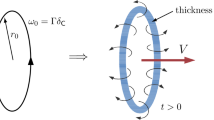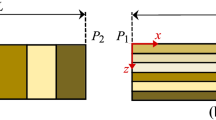Abstract
Disturbance evolution in developed turbulent flows in a plane channel is numerically investigated at the Reynolds numbers up to Reτ = 586. Steady turbulent flows calculated on the basis of the solution of the incompressible Navier—Stokes equations are then used as the baseline flows in studying the disturbance development process. The values of the highest Lyapunov exponent (HLE) λ1 are found and the instantaneous and statistical properties of the corresponding leading Lyapunov vector (LLV) are determined. Under arbitrary initial conditions the regime of the exponential disturbance growth ~ exp(λ1t) is reached for a time Δt+ < 50. It is found that the HLE value increases with the Reynolds number from λ1+ ≈ 0.021 at Reτ = 180 to λ1+ ≈ 0.026 at Reτ = 586. The LLV exhibits itself in the form of time- and space-localized spots of highly intense pulsations, concentrated in the buffer layer region. The distributions of the r.m.s. intensities of the velocity and vorticity pulsations in the LLV are qualitatively similar with the corresponding distributions in the main flow with near-wall streaks artificially extracted from it. The difference is a large disturbance concentration in the vicinity of the buffer layer, y+ = 10–30, and a relatively high (about 80% higher) vorticity pulsations amplitude. Basing upon the energy spectra of the velocity and vorticity pulsations we determined the integral spatial scales of the structures in the LLV field. It is found that the LLV structures are on average half as wide and long as the corresponding structures in the main flow. The contributions of all the terms included in the expression for the production of the kinetic energy of disturbances are determined. It is shown that the process of disturbance development is essentially controlled by the main flow inhomogeneity and the occurrence of transverse motion in it. Neglecting these factors leads to a considerable underestimation of the disturbance growth rate. Contrariwise, the presence of near-wall streaks in the main flow does not play a considerable role in the LLV disturbance development. The artificial extraction of the streaks from the main flow field does not change the nature of disturbance growth.
Similar content being viewed by others
References
P. S. Klebanoff, K. D. Tidstrom, and L. M. Sargent, “The three-dimensional nature of boundary-layer instability,” J. Fluid Mech. 12(1), 1–34 (1962).
S. J. Kline, W. C. Reynolds, F. A. Schraub, and P. W. Runstadler, “The structure of turbulent boundary layers,” J. Fluid Mech. 30(4), 741–773 (1967).
M. T. Landahl, “A note on an algebraic instability of inviscid parallel shear flows,” J. Fluid Mech. 98(2), 243–251 (1980).
T. A. Zaki, “From streaks to spots and on to turbulence: exploring the dynamics of boundary layer transition,” Flow, Turbul. Combust. 91(3), 451–473 (2013).
V. V. Kozlov, G. R. Grek, Yu. A. Litvinenko, S. N. Tolkachev, and V. G. Chernoray, “Experimental investigations of localized disturbances and their secondary high-frequency instability in boundary layers on a flat plate and straight and swept wings (an Overview),” Vestnik Novosibirsk Univ. Ser. Fizika 9(4), 39–64 (2014).
C. R. Smith and S. P. Metzler, “The characteristics of low-speed streaks in the near-wall region of a turbulent boundary layer,” J. Fluid Mech. 129, 27–54 (1983)).
H. T. Kim, S. J. Kline, and W. C. Reynolds, “The production of turbulence near a smooth wall in a turbulent boundary layer,” J. Fluid Mech. 50, 133–160 (1971)).
K. Hamilton, J. Kim, and F. Waleffe, “Regeneration mechanisms of near-wall turbulence structures,” J. Fluid Mech. 287, 317–348 (1995)).
J. Jimenez and A. Pinelli, “The autonomous cycle of near-wall turbulence,” J. Fluid Mech. 389, 335–359 (1999)).
W. Schoppa and F. Hussain, “Coherent structure generation in near-wall turbulence,” J. Fluid Mech. 453, 57–108 (2002).
F. Waleffe, “Hydrodynamic stability and turbulence: beyond transients to a self-sustaining process,” Stud. Appl. Math. 95(3), 319–343 (1995).
F. Waleffe, “On a self-sustaining process in shear flows,” Phys. Fluids 9(4), 883–900 (1997).
P. S. Jang, D. J. Benney, and R. L. Gran, “On the origin of streamwise vortices in a turbulent boundary layer,” J. Fluid Mech. 169, 109–123 (1986)).
J. W. Brooke and T. J. Hanratty, “Origin of turbulence producing eddies in a channel flow,” Phys. Fluids A. Fluid Dynamics 5(4), 1011–1021 (1993).
K. M. Butler and B. F. Farrell, “Optimal perturbations and streak spacing in wall-bounded turbulent shear flows,” Phys. Fluids A. Fluid Dynamics 5(3), 774–777 (1993).
N. V. Nikitin and S. I. Chernyshenko, “On the nature of the organized structures in turbulent near-wall flows,” Fluid Dynamics 32(1), 18–23 (1997).
W. Schoppa and F. Hussain, “Formation of near-wall streamwise vortices by streak instability,” AIAA Paper No. 3000 (1998), pp. 61–78.
S. I. Chernyshenko and M. F. Baig, “The mechanism of streak formation in near-wall turbulence,” J. Fluid Mech. 544, 99–131 (2005)).
F. Waleffe and J. Kim, “How streamwise rolls and streaks self-sustain in a shear flow,” in: R. Panton (ed.), Self-Sustaining Mechanisms of Wall Turbulence. Computational Mechanics Publications (1997), pp. 309–332.
W. Schoppa and F. Hussain, “Genesis and dynamics of coherent structures in near-wall turbulence: A New Look,” in: R. Panton (ed.), Self-Sustaining Mechanisms of Wall Turbulence. Computational Mechanics Publications (1997), pp. 385–422.
G. Kawahara, J. Jiménez, M. Uhlmann, and A. Pinelli, “The instability of streaks in near-wall turbulence,” CTR Annu. Res. Briefs, Stanford University, 1998, pp. 155–170.
B. F. Farrell and P. J. Ioannou, “Generalized stability theory. Part II. Non-autonomous operators,” J. Atmos. Sci. 53(14), 2041–2053 (1996).
B. F. Farrell and P. J. Ioannou, “Dynamics of streamwise rolls and streaks in turbulent wall-bounded shear flow,” J. Fluid Mech. 708, 149–196 (2012)).
B. F. Farrell, P. J. Ioannou, J. Jiménez, N. C. Constantinou, A. Lozano-Durán, and M.-A. Nikolaidis, “A statistical state dynamics-based study of the structure and mechanism of large-scale motions in plane poiseuille flow,” J. Fluid Mech. 809, 290–315 (2016)).
D. A. Egolf, I. V. Melnikov, W. Pesch, and R. E. Ecke, “Mechanisms of extensive spatiotemporal chaos in Rayleigh-Bénard convection,” Nature 404, 733–736 (2000).
A. Jayaraman, J. D. Scheel, H. S. Greenside, and P. F. Fischer, “Characterization of the domain chaos convection state by the largest lyapunov exponent,” Phys. Rev. E 74(1), 016209 (2006).
M. Xu and M. R. Paul, “Covariant Lyapunov vectors of chaotic Rayleigh-Bénard convection,” Phys. Rev. E 93(6), 062208 (2016).
T. S. Parker and L. O. Chua, Practical Numerical Algorithms for Chaotic Systems (Springer, New York, 1989).
F. Ginelli, P. Poggi, A. Turchi, H. Chatre, R. Livi, and A. Politi, “Characterizing dynamics with covariant lya-punov vectors,” Phys. Rev. Lett. 99(13), 130601 (2007).
N. Nikitin, “On the rate of spatial predictability in near-wall turbulence,” J. Fluid Mech. 614, 495–507 (2008)).
N. V. Nikitin, “Disturbance growth rate in turbulent wall flows,” Fluid Dynamics 44(5), 652–657 (2009).
S. Unnikrishnan and D. V. Gaitonde, “A high-fidelity method to analyze perturbation evolution in turbulent flows,” J. Comput. Phys. 310, 45–62 (2016)).
N. Nikitin, “Spatial periodicity of spatially evolving turbulent flow caused by inflow boundary condition,” Phys. Fluids 19(9), 091703 (2007).
L. Keefe, P. Moin, and J. Kim, “The dimension of attractors underlying periodic turbulent poiseuille flow,” J. Fluid Mech. 242, 1–29 (1992))
M. Inubushi, S.-I. Takehiro, and M. amada, “Regeneration cycle and the covariant lyapunov vectors in a minimal wall turbulence,” Phys. Rev. E 92(2), 023022 (2015).
N. V. Nikitin and D. E. Pivovarov, “Perturbation growth rate in turbulent couette flow,” Fluid Dynamics 53(6), 723–728 (2018).
N. Nikitin, “Finite-difference method for incompressible Navier-Stokes equations in arbitrary orthogonal curvilinear coordinates,” J. Comput. Phys. 217, 759–781 (2006)).
R. D. Moser, J. Kim, and N. N. Mansour, “Direct numerical simulation of turbulent channel flow up to Reτ = 590,” Phys. Fluids 11(4), 943–945 (1999).
X. Wu, P. Moin, J. M. Wallace, J. Skarda, A. Lozano-Duran, and J.-P. Hickey, “Transitional-turbulent spots and turbulent-turbulent spots in boundary layers,” Proc. Nat. Acad. Sci. USA 114(27), E5292–E5299 (2017).
J. Jeong, F. Hussain, W. Schoppa, and J. Kim, “Coherent structures near the wall in a turbulent channel flow,” J. Fluid Mech. 332, 185–214 (1997)).
J. Jeong and F. Hussain, “On the identification of a vortex.” J. Fluid Mech. 285, 69–94 (1995)).
H. Tennekes and J. L. Lumley, A First Course in Turbulence (M.I.T. Press, 1972)
Author information
Authors and Affiliations
Corresponding authors
Additional information
Russian Text © The Author(s), 2019, published in Izvestiya RAN. Mekhanika Zhidkosti i Gaza, 2019, No. 2, pp. 72–93.
Rights and permissions
About this article
Cite this article
Nikitin, N.V., Popelenskaya, N.V. Characteristics of the Instability Developing in the Turbulent Flow in a Plane Channel. Fluid Dyn 54, 218–238 (2019). https://doi.org/10.1134/S0015462819020101
Received:
Revised:
Accepted:
Published:
Issue Date:
DOI: https://doi.org/10.1134/S0015462819020101




